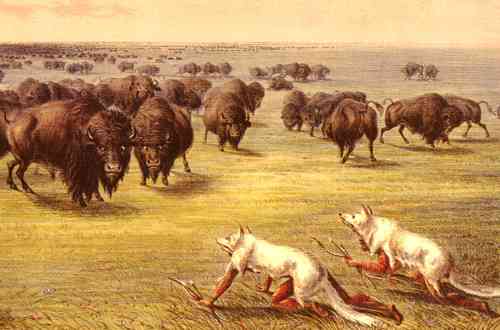

8th American History
Rossville Jr. High
Plains History Project
2004
|
|
|
| Hunting the buffalo was an important part of getting food. It required skill, good horses, and more skill. Cooking was the women's job. After the women gutted the animal they would start taking out all the body parts they were going to use. Storage was a vigorous process because when they were going to store the meat, they had to make jerky, pemmican, or saturate it in fat and keep out of the air in a buffalo hide bag. The buffalo also made many, many things. Some tribes, for example: Kootenai, would throw away all the insides except for the heart; where others would use everything. | |
| Before hunting the warriors had to make sure that they had everything. They needed a trained horse that didn't get scared when the buffalo was stampeding right next to them. They had to have all their equipment to shoot the buffalo. After they have that they needed to figure out if they would just start shooting them or if they would Piskin. Piskin is when the Indians trick them to stampede over a cliff. While hunting, the Indians had to decide if they wanted to keep hunting to add to the winter's supply of just get enough for everyone. If they wanted to keep hunting they would cache the meat. When they did this, they placed the meat between 2 hides some where out of the way and picked it up later. This was only temporary means of storage. After hunting they would start gutting it and take out all the parts they wanted. While this was happening they would snack on raw meat or drink the warm blood. They would even drink the gristle from the snout, They believed that if you drank the blood it would help you in battle when blood shed was everywhere. If they were hunting on enemy's land whole meals would be raw, uncooked meat so that nobody would see their smoke. | |
| Cooking usually was making jerky, but they also used the marrow in the bones. They would set it next to the fire then crack it open and eat it. They also used it as a base for soup. They used hot, melted marrow and poured it into a rawhide bag that held pulverized jerky and whatever else they wanted in it. They sewed it shut then walked on it to flatten it to six or seven inches. One of the bags could weigh ninety pounds. Some popular dishes were boiled fetal buffalo calf and calf heads. To cook these they made fire pits and placed them in there. There was a two-inch-thick fatty tissue on the hump( the French called it "depouille"). The Blackfoot tribes would dip it into hot grease and hung it high in their lodge where it was smoked. Some used it as a bread and put jerky in between it. | |
| When the Indians stored the meat they had several choices of how to store it. The most popular long-time storage was dehydration They sliced the meat up thin, hung them on scaffolds with streamers placed with them, then when the wind blew, it helped keep the wolves away. They could saturate it in fat and with out contact with air it could last for a long time (it was concealed in a rawhide bag). Another way to keep meat was making it into pemmican or jerky. Dried buffalo jerky weighed 1/6 what the original fresh meat weighed. when rain or damp air got to it, it usually started to mold and decay which would make it heavier. Jerky was often pounded then dipped in melted fat to make chewing easier, Pemmican eliminated problems with jerky. | |
| Buffalo provided Indians almost everything they needed to live. One buffalo could make 100 things in all. Clothes were something it provided. They made robes and shoes and shirts and hats. Coats and capes, dresses and belts. Mittens and leggings, underclothes and Breech clothes. They made their tipi's and they made tipi covers. Door flops to bedcovers, medicine cases to trunks. They made ceremonial objects like: Sundance alters and rattles. They even made winding sheets for the dead. They made snow shoes to dice, netting for lacrosse hoops to ball covering and the stuffing. They made all the things for their horse like saddles, saddle blankets, and all the straps. They made pouches for tobacco and berries and even Honda rings. They made some of their weapons and got their bow strings. They got all their tools and utensils like eating utensils and buckets. Brushes, soaps, thread, and glue. They could even make a boat if they needed it. | |
| The buffalo were very important to the Indians. They had been getting their supplies from them for a very long time. Then the white man came, and when they started to search westward they started to kill buffalo and at first the Indians didn't care. But after the white men started to move the Indians onto reservations and almost wiped out the buffalo. Fortunately, they were saved and the amount of the buffalo is coming back up. |
|
| Jessica Leigh Venneberg
8th American History Rossville Jr. High Plains History Project 2004 |
|